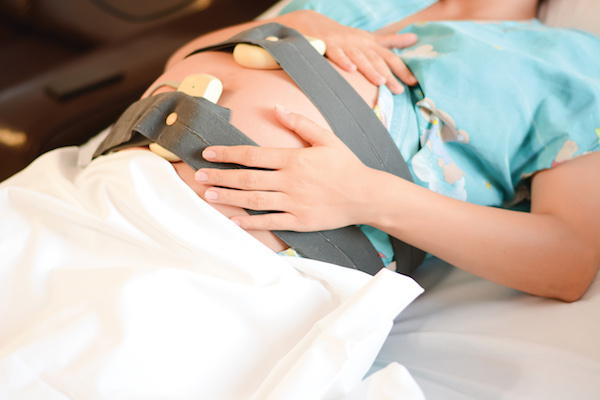Terms and conditions

Fontanelle, episiotomy, meconium—oh my! With all that jargon spinning around in your head, you may feel like you’re back in grade school staring down a vocabulary quiz. And that’s not a distraction you need when you’re trying get a tiny human out of your body. Read up on the most common technical terminology, so you’ll be a whiz at any words your labor nurse throws at you.
Anatomy
Amniotic sac. Sometimes called a “bag of waters” or “membranes,” this sac of clear amniotic fluid is where your itty-bitty bean grows inside the uterus. Your baby’s water bed cushions her from injury, helps maintain a constant temperature and protects her from infection. The most important thing you need to know? When it ruptures and your water breaks (on its own or with your care provider’s help), baby is coming soon.
Cervix. This narrow, neck-like passage makes up the lower part of the uterus and connects it to the vagina. The cervix is about an inch wide, but it opens during childbirth (see: dilation), so baby can pass through to make her exit.
Cord blood. You guessed it—it’s the blood left in the umbilical cord and placenta after birth. This blood is packed with stem cells that are genetically unique to your newborn and close relatives. It can be collected and stored (or donated) for future medical use.
Fontanelle. Nicknamed “soft spots” on an infant’s skull, fontanelles are spaces where skull bones come together but have yet to harden. A baby may have several; find them at the top, back and sides of her noggin. These gaps allow the head to compress as it passes through the birth canal. Don’t worry: Everything will shift back to normal and solidify soon enough.
Perineum. Extending from the anus to the opening of the vagina, this area of tissue and muscle can tear (or might be intentionally cut by your health care provider; see: episiotomy) during delivery.
Placenta. This organ attaches to the lining of the uterus during pregnancy and keeps baby’s blood supply separate from yours. Remember, after your newbie is on the outside, you’ll still need to deliver the placenta. Contractions help pass it, but you’ll hardly notice—you’re going to be too busy staring at that sweet new face.
Umbilical cord. This cord is vital in getting baby the oxygen and nutrients she needs, all
of which come from mama’s bloodstream. It’s impossible to miss this (on average) 20-inch cord in the labor room. Not long after birth, it’ll be clamped about 2 inches from baby’s belly button and again near the placenta before it’s cut in between. Breathe easy—neither you nor your mini will feel a thing!
Physical changes
Contractions. The uterine muscles (the ones that help push baby down the birth canal) periodically tighten and relax, which is what’s called a contraction. They’ll grow stronger and come more frequently as labor progresses.
Crowning. This is the moment when your babe’s head pushes through the fully dilated cervix and into the birth canal. It’s been dubbed the “ring of fire” because of the burning sensation that occurs as the perineum stretches.
Dilation. Measured in centimeters from 0 to 10, this explains how much your cervix has opened in preparation for childbirth. You want to get to a wide-open 10 because being “fully dilated” means you can start pushing.
Effacement. Measured on a percent scale, this term describes the softening and thinning of the cervix. Higher is better. One hundred percent effaced, sometimes called a “paper thin” cervix, is when it’s time to push.
Transition. Following active labor but before pushing, this is the phase when your cervix dilates from 8 centimeters all the way to 10. Contractions will be strongest and most frequent at this time; thankfully, it’s the shortest phase.
Equipment & procedures
Amniotomy. This is the artificial rupturing of the amniotic sac, commonly performed with an amniotic hook (picture a plastic crochet needle), in an attempt to induce or speed up labor.
Episiotomy. As part of this procedure, an incision is made to the perineum to widen the vaginal opening for delivery. This is optional, so your doctor should ask for your permission first.
External fetal monitor (EFM). Using two belts across your belly, this noninvasive device is used intermittently throughout labor to record baby’s heartbeat and your contractions. Keep in mind, it does limit mobility when in use.
Forceps. These tong look-alikes might be used to assist delivery by applying a grip on the baby’s head and gently pulling outward.
Internal fetal monitor (IFM). This monitor can be used only if the amniotic sac has ruptured. It’s more invasive, so it’s mostly used in high-risk pregnancies or if the external monitor isn’t giving an accurate reading. With an IFM, a small fetal-scalp electrode is placed on baby’s head to measure heart rate.
Vacuum extractor. This suctioning tool features a metal or plastic cup with a handle and vacuum pump. The cup is attached to baby’s head during a contraction (while mama pushes) to assist with her exit. It’s recommended only if labor isn’t progressing or an immediate delivery is necessary because of health risks.
Medications
Epidural. This block-all-feeling pain reliever numbs the lower part of your body while allowing you to stay conscious and alert. It’s administered continuously during labor through a catheter that is threaded through a needle near your spinal cord.
Narcotics. If your nurse mentions these, she’s talking about pain relievers. (Examples include morphine, fentanyl, Nubain, Demerol and Stadol.) These medications are given in early or active labor via IV or injection. They will dull pain but not eliminate it, and effects aren’t localized, which means your entire body will feel it.
Pitocin. This synthetic form of the body’s natural hormone oxytocin stimulates contractions of the uterus, which is why this drug is used to induce labor.
Spinal block. Like an epidural, this anesthetic numbs your lower body. Unlike epidurals, it is a one-time injection into the spinal fluid that wears off after a
few hours.
Postpartum
Afterbirth. The placenta and membranes that are expelled from the uterus after labor and delivery.
APGAR score. This post-birth assessment is taken both one and five minutes after birth to measure your baby’s appearance, pulse, grimace, activity and respiration (APGAR). Each is rated on a scale of 0 to 2; add the five numbers together for your tot’s total score (0-10) and a quick evaluation of her health.
Colostrum. Thin and white in appearance, this fluid is a precursor to mama’s breast milk production. It’s high in protein, low in fat and full of antibodies, which happens to be just what newborns need.
Meconium. Sticky and dark (almost black) in color, this tar-like substance describes your little one’s first bowel movements—not something you want for the baby book. It will likely make an appearance in the first 48 hours and last through day four, when stools change because of your babe’s new diet.
Vernix. The waxy, cream-colored substance that coats and protects your bundle’s skin in utero probably isn’t how you imagined seeing your baby for the first time, but it can be washed—or wiped—off soon after birth.







